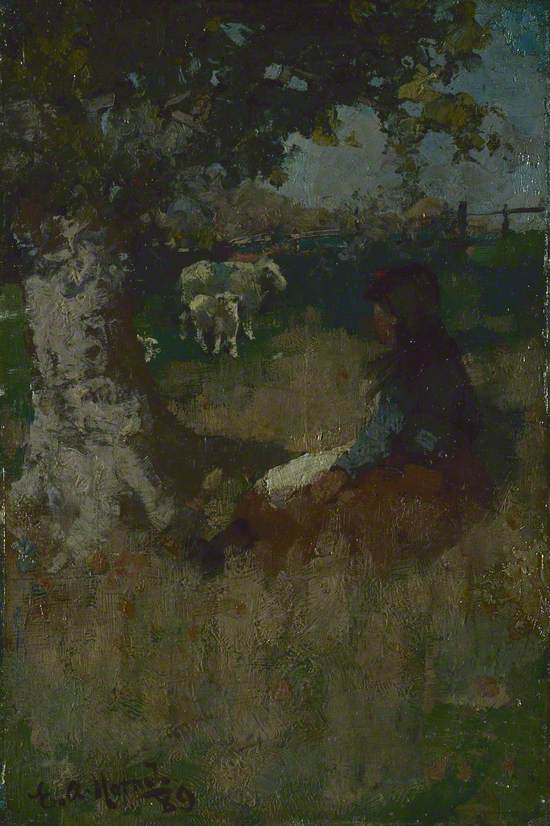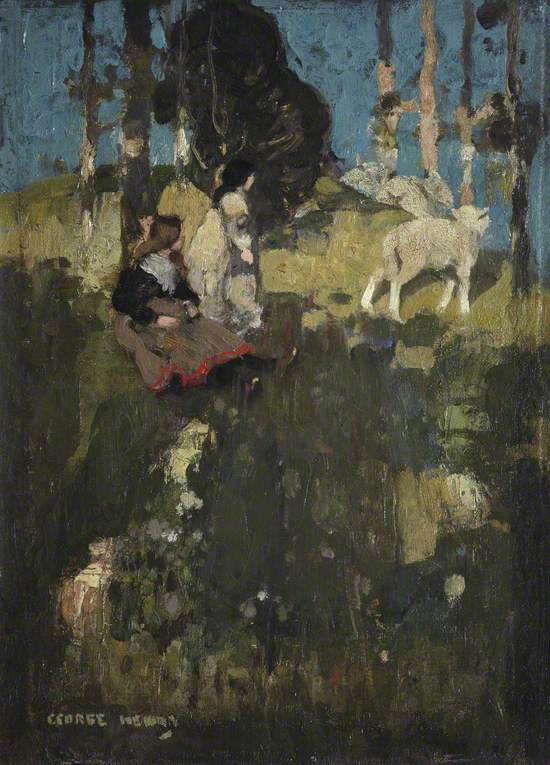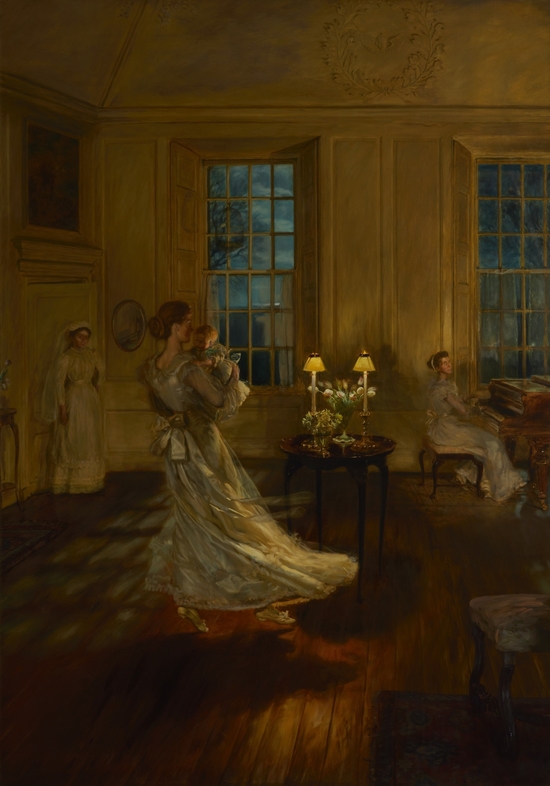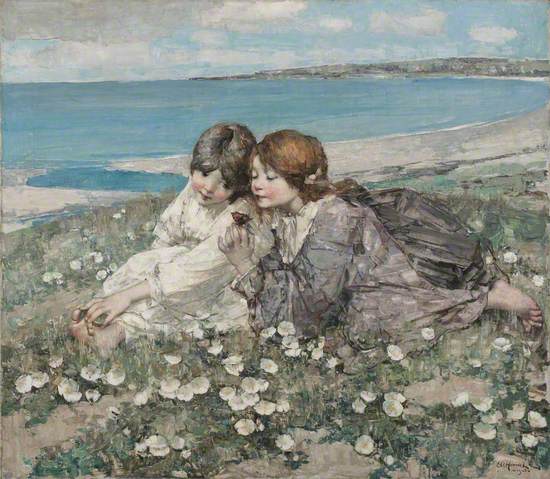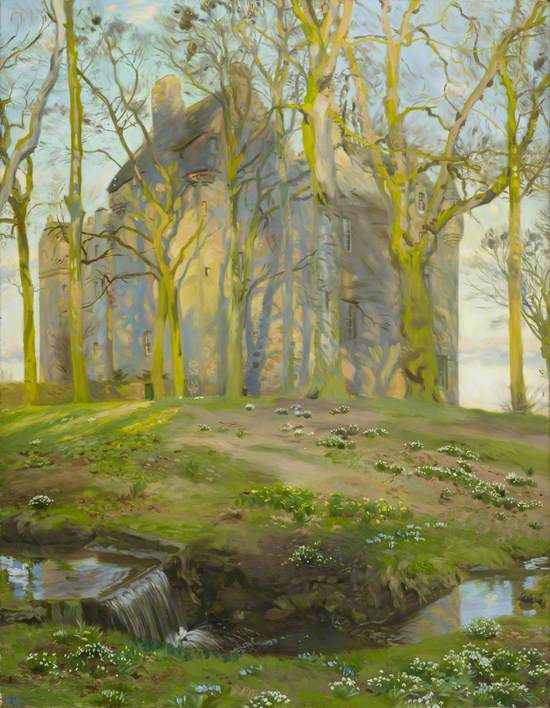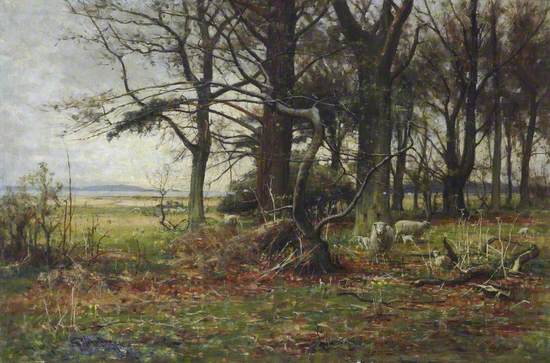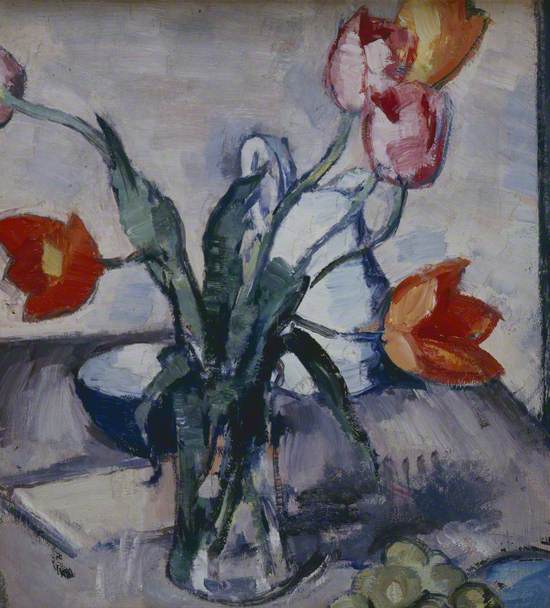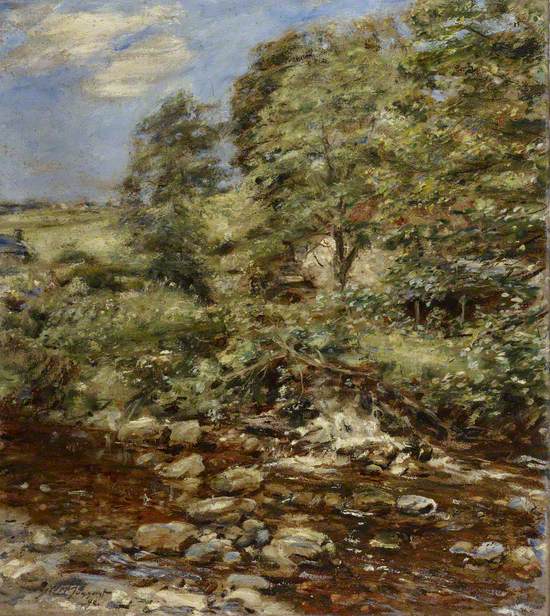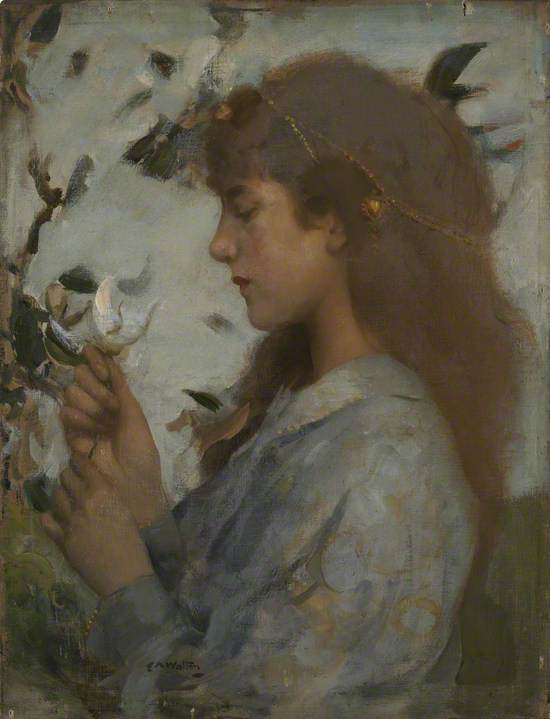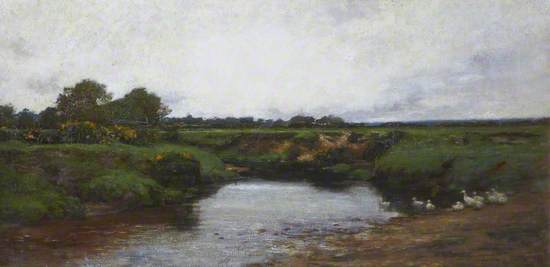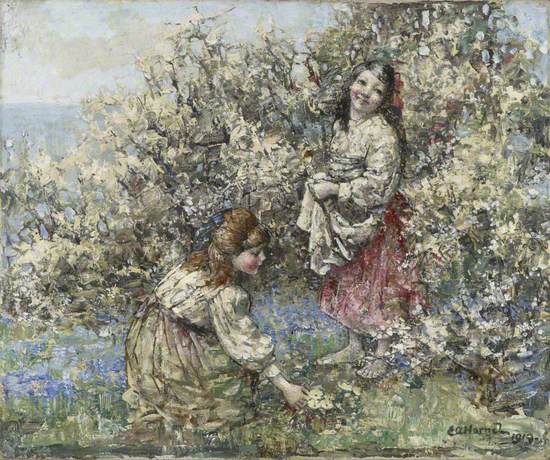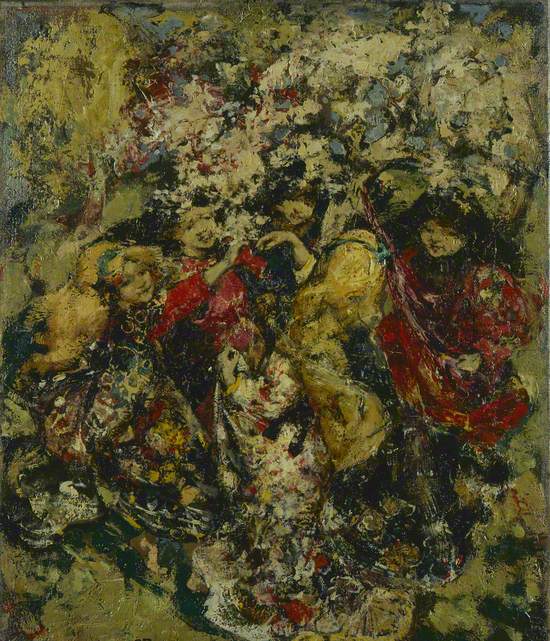Spring is a time of rebirth and renewal. Trees bud, fields and hedgerows bloom with early flowers, bright yellow daffodils make their appearance in our gardens – the earth comes to life again and the world seems brighter.
In celebration of this magical time of year we've chosen some our favourite Spring themed paintings from our collections. There are lots of famous names here but also some lesser-known gems. We hope you enjoy looking at them as much as we enjoyed selecting them.
A Spring Day, Morocco
Thomas Millie Dow is the only Fife-born member of the Glasgow Boys. He came from a family of Dysart solicitors and was expected to join the family practice. He chose instead to train as an artist. Although he lived in St Ives, Cornwall, from 1895, Dow continued to exhibit in Scotland throughout his life.
Several of the Glasgow Boys had homes in North Africa and Dow was a frequent visitor. This painting – with its soft, subtle colours and dreamlike quality - is typical of his trademark style. The irises in the foreground, wonderful purple and white spring flowers, are the focal point, with a winding road leading up through verdant pastures to a hilltop village, the hazy heat of the day hanging heavy in the air.
Landscape with a Girl and a Sheep
Born in Australia, Hornel’s parents emigrated to Scotland when he was around 18 months old, settling in Kirkcudbright in the Borders. He went on to become famous as one of the Glasgow Boys. Like most of the Boys, his early work focused on scenes of Scottish rural life. From the late 1880s he began to explore a different style of painting, alongside his great friend, George Henry. Colours became stronger, with much use of impasto, applying paint as thickly as paste.
This depiction of a young shepherdess and her flock taking shelter from the midday sun is an idyllic scene. The bright reds and blues of her dress and the white splash of her apron create a wonderful focal point against the subtle browns and greens of nature.
Edward Atkinson Hornel (1864–1933)
Oil on canvas
H 30.5 x W 20.5 cm
Fife Council
Spring Time
Henry was born in Irvine, on the west coast of Scotland. Spring Time was painted shortly after A Galloway Landscape, the painting that announced his departure from the realism of the rural scenes he, and many of the other Glasgow Boys, had favoured.
The painting has a flat, carpet-like patterning, with colours, figures and landscape blending seamlessly together. The trees, still just in bud, stand out against the cloudless blue of the sky, with the red stripe around the girl’s skirt immediately drawing the eye, a flash of colour against the dark shadow on the grass. The bond between the girl and her animals is strikingly portrayed, she is sitting beneath a tree with one of her flock resting at her side, the others hovering close by.
Spring, Comrie
One of four artists now known as the Scottish Colourists, Peploe is celebrated for his still life paintings and his landscapes. Many of his Scottish landscapes feature Hebridean islands, such as Barra or Iona. Here, we are in Comrie, a Perthshire village near Crieff.
The subtle colours and the dot-dash pattern of the paint (sometimes known as 'pointillism') give the effect of a delicate piece of needlework. The spidery branches of the trees are just beginning to make the move from bud to blossom, creating a lovely lattice-work through which we can make out a tantalising glimpse of whitewashed cottages. The scene is brimming with the promise of more delights to come, as Spring slowly unfurls, before suddenly bursting into life.
Spring Moonlight
Born in Edinburgh, Lorimer came from an artistic family. His brother, Robert, was a famous architect, his nephew, Hew, a famous sculptor. In 1878 the family acquired the lease to Kellie Castle, near Pittenweem, Fife, and set about restoring it for use as a holiday home. Lorimer set up a studio in one of the towers and many of his paintings feature the house and its beautiful gardens.
Set in the drawing room at Kellie Castle, this painting is a favourite with visitors to Kirkcaldy Galleries. The simple joy of a young mother, bathed in the soft golden glow of moonlight on a Spring evening, dancing with her child in her arms, while a delighted maid looks on – a scene of love and contentment that has captured many a heart.
Calves
Gauld was the youngest member of the Glasgow Boys. His early work was heavily influenced by the Celtic Revival, or Symbolist, movement. He was a also a great admirer of the Pre-Raphaelites. From around 1910, however, he became known for his paintings of cattle in landscapes. We have two such works in our collections – Calves and Repose.
One of the greatest joys of spring is the arrival of new life in the fields and pastures. There is something incredibly soothing in this painting, one calf seeming to watch over the other as it rests in the dappled shade of the tree, surrounded by lush, green grass, under a clear, blue sky.
Broken Weather, Port Seton
McTaggart is one of Scotland’s most celebrated landscape painters. Born in Aros, Kintyre, he moved to Edinburgh aged 16 to study at the Trustees’ Academy but he never lost his love of the sea and Scotland’s wild coastline. We are privileged to have over 30 works by McTaggart in our collections.
Port Seton is a fishing village about 10 miles south of Edinburgh. Here we see a rocky shore, the gathering clouds of a rainstorm reflecting on the water. There is a break in the clouds, a small patch of blue. Is it coming? Or going? In the distance we can just make out Arthur’s Seat and Salisbury Crags, with the distinctive sail of a Fifie fishing boat hoving into view on the far right.
William McTaggart (1835–1910)
Oil on canvas
H 62.5 x W 80.5 cm
Fife Council
Seashore Roses
Seashore Roses is one of the most popular paintings in our collections. Hornel’s mastery of colour is beautifully demonstrated – the light blue of the sky, dotted with fluffy white clouds, blending into the turquoise of the sea, surrounded by a fringe of golden sand. In the foreground, the two young girls paint a pretty picture, relaxing on a bed of marram grass dotted with small white flowers. A final touch is the gorgeous red and black butterfly sitting daintily on the girl’s hand, the burnished copper of her hair shining out against the subtle mauve of her dress. It’s a beautiful, tranquil scene, celebrating the joy of childhood friendship, the abundance of nature and the pleasure to be had in the warmth of a Spring day.
Edward Atkinson Hornel (1864–1933)
Oil on canvas
H 102.5 x W 117 cm
Fife Council
Sundown in Spring, Kellie Castle
Painted at the Lorimer family’s holiday home, Kellie Castle, near Pittenweem, the scene is that of the light slowly fading over the house and grounds as a beautiful Spring day draws to a close. The trees – not yet in leaf – are stark against the sky, but with the promise of buds ready to burst into life at any moment. The banks of the gently flowing burn are liberally scattered with hundreds of delicate, white snowdrops, nodding their delicate heads in the evening breeze – welcome harbingers of the end of winter and the promise of new beginnings.
John Henry Lorimer (1856–1936)
Oil on canvas
H 114.5 x W 89 cm
Fife Council
Spring Time in Dalmeny Woods
Born in the village of Glamis, Angus, Johnstone lived most of his adult life in Edinburgh. He became known for his portraits and landscapes, the latter painted mainly in Eskdale and Annandale, in the Scottish Borders. Dalmeny is a village in West Lothian, about a mile from South Queensferry. Over in the distance we can see the distinctive outline of the Fife coast.
This is a lovely depiction of the land coming back to life. There is a patch of bluebells in the foreground, and the yellow of woodland daffodils dotted around. Sheep, with newborn lambs, rest in the shade of the trees – one of the sheep seemingly looking straight at us as, if spotting an interloper, come to disturb their idyll.
George Whitton Johnstone (1849–1901)
Oil on canvas
H 51 x W 76.5 cm
Fife Council
Tulips
We are privileged to have the largest collection of Peploes outwith the National Galleries of Scotland – 46 in total. This is one of two still lifes featuring tulips.
Peploe spent much of his life in pursuit of the ‘perfect’ still life. ‘There is so much in mere objects, flowers, leaves, what not – colours, forms, relation – I can never see the mystery coming to an end’. Tulips are one of our best-loved late Spring flowers, with their myriad of colours and beautiful shapes – from simple champagne flutes to multi-petalled and fringed varieties. Even as a cut flower they are magical, their stems elongating in water and their petals unfurling, creating ever-evolving shapes, so wonderfully captured here by Peploe.
Spring, Carrington Mill
Spring, Carrington Mill oozes abundance. Trees are in full leaf, bushes and shrubs are flourishing, flowers in shades of blue and white dot the ground, rising up the banks of a shallow burn. The sky is a bright, azure, with no sign of rain. It’s a perfect Spring day. The only sound is the burn gurgling its way over the stones and perhaps the faint bleating of sheep and their new-born lambs somewhere in the distance. An ideal place to relax and daydream.
William McTaggart (1835–1910)
Oil on canvas
H 95 x W 84.5 cm
Fife Council
The White Flower
Born in Renfrewshire, Walton is another of the Glasgow Boys. Like most of the group, his earlier work focused on landscapes but he later became known as an accomplished and sought-after portrait painter.
The White Flower was first exhibited in Berlin in 1900. Many of Walton’s paintings, both landscapes and portraits, have a soft, dreamlike quality. There is something reminiscent of the Pre-Raphaelites in this painting of a young woman, posed in profile, her long, chestnut hair flowing down her back, wearing a loose-fitting dress in a soft shade of blue. The juxtaposition of a beautiful girl and an immaculate white flower is a celebration of the glory of youth and the purity of nature, the two intertwined in perfect harmony.
Evening in Spring
John Leslie Thomson was a Scottish landscape artist. He lived for many years in London but painted rural landscapes and seascapes in various locations around the UK and in France.
The magic of twilight, that brief interlude where day meets evening, is beautifully captured here. There is a faint lilac tinge to the slowly darkening skies and the riverbank and ford is deserted, save for a gaggle of geese enjoying the end of a warm Spring day. The yellow of the broom glows brightly against the dark green of the foliage, a promise of things to come in the days and weeks ahead.
Gathering Spring Flowers
Gathering Spring Flowers was painted in 1919. Once regarded as the most innovative of the Glasgow Boys, by this time Hornel’s work had become a little formulaic. He did, however, retain his wonderful sense of colour and the public continued to clamour for his work.
Although there is perhaps a ‘chocolate-box’ feeling to this painting, there’s also an overwhelming sense of happiness and innocence – pretty young girls with ribbons in their hair picking wildflowers on a sunny day. It’s a celebration of nature's bounty and the joy to be had in simple pleasures. The flowers carpeting the ground around the girls’ feet, fluffy white clouds in a bright blue sky, no need for coats and hats - springtime at its finest.
Edward Atkinson Hornel (1864–1933)
Oil on canvas
H 51 x W 61.5 cm
Fife Council
Links Fair, Kirkcaldy
Kirkcaldy's Links Market is the longest street fair in Europe and the oldest in Scotland. First held in 1304,it’s still going strong, although in a rather different format. Held over six days in mid April, the fair stretches the length of the Esplanade, a mile long. It promises, ‘every conceivable fairground attraction’, with visitors coming from all over the UK.
Painted in 1884, this scene is very different to the one you’d witness today but the essence of the fair remains the same. Down through the generations the Links Fair has brought with it the promise of warmer weather and of summer on the horizon, with family and friends coming together to have fun and soak up the atmosphere.
James Patrick (active 1880–1905)
Oil on canvas
H 74 x W 126 cm
Fife Council
Maytime
May Day, or Beltane, the 1st of May, is traditionally a time to celebrate the return of life and fertility to the earth. One of the most enduring traditions in Scotland was young girls heading out at dawn to wash their faces in the dew, (said to give you a clear complexion and bring you luck in the year ahead), and gather wildflowers.
Hornel’s painting is a riot of colour – the girls, revelling in their youth and beauty, dancing and laughing in a playful swirl of bright reds and vivid yellows, surrounded by abundant pink and white blossom. Summer is on its way, with the promise of longer days, warmer weather and happy times to come.
Explore artists in this Curation
View all 11-
 George Henry (1858–1943)
George Henry (1858–1943) -
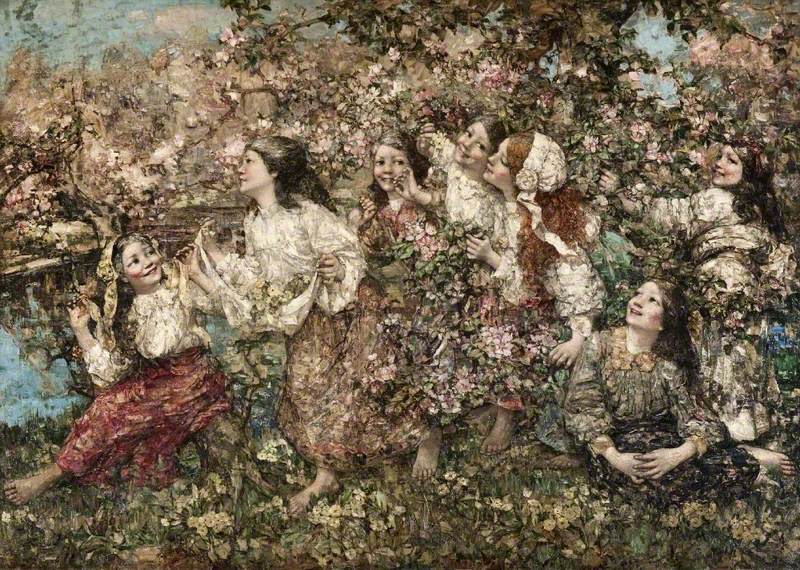 Edward Atkinson Hornel (1864–1933)
Edward Atkinson Hornel (1864–1933) -
 James Patrick
James Patrick -
 George Whitton Johnstone (1849–1901)
George Whitton Johnstone (1849–1901) -
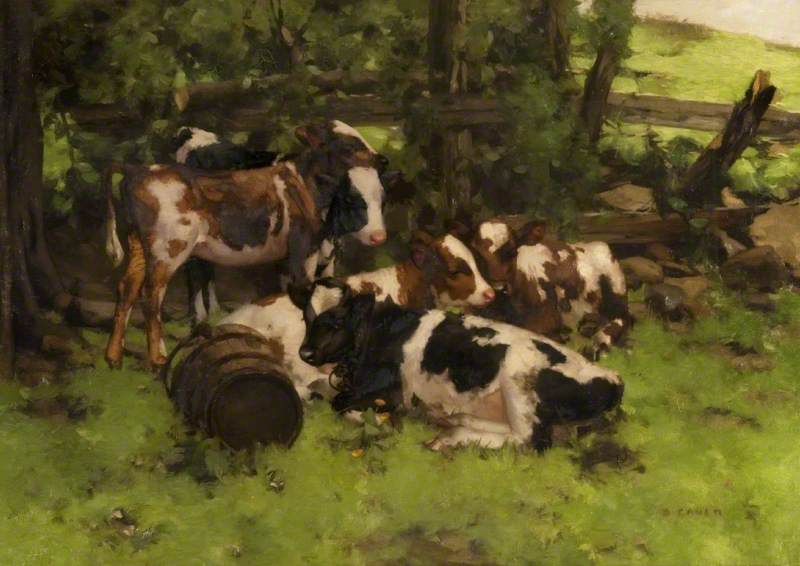 David Gauld (1867–1936)
David Gauld (1867–1936) -
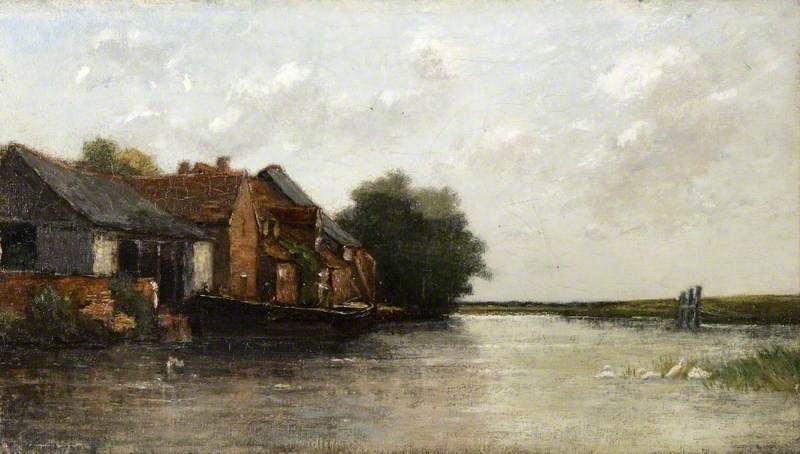 John Leslie Thomson (1851–1929)
John Leslie Thomson (1851–1929) -
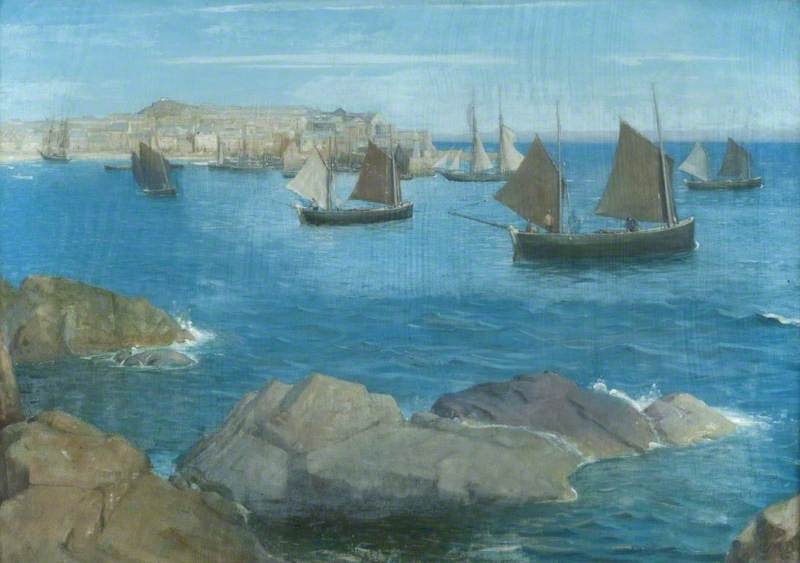 Thomas Millie Dow (1848–1919)
Thomas Millie Dow (1848–1919) -
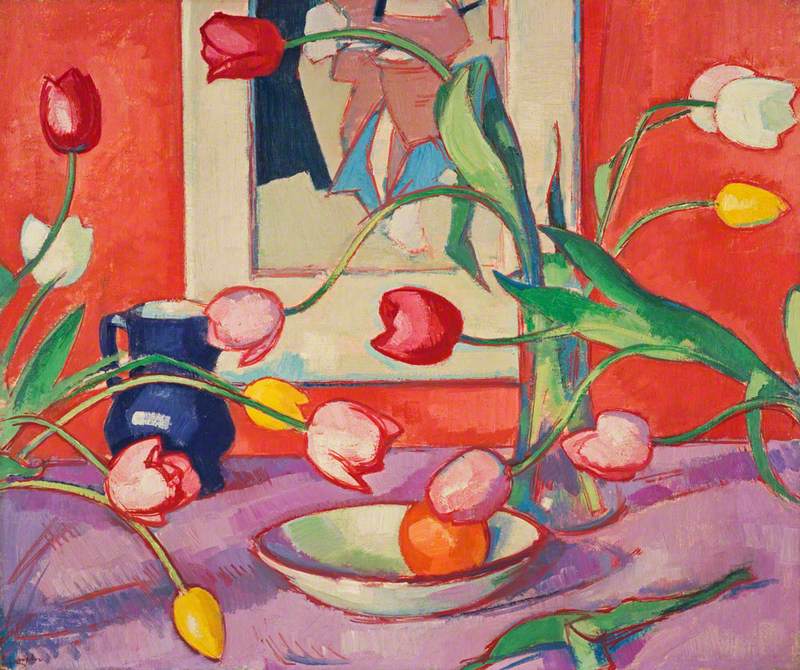 Samuel John Peploe (1871–1935)
Samuel John Peploe (1871–1935) -
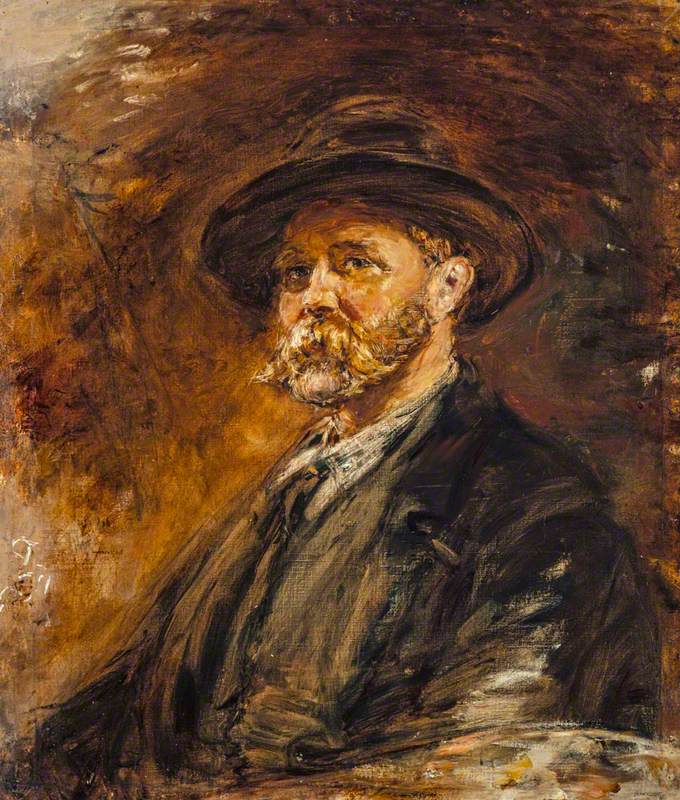 William McTaggart (1835–1910)
William McTaggart (1835–1910) -
 John Henry Lorimer (1856–1936)
John Henry Lorimer (1856–1936) - View all 11

